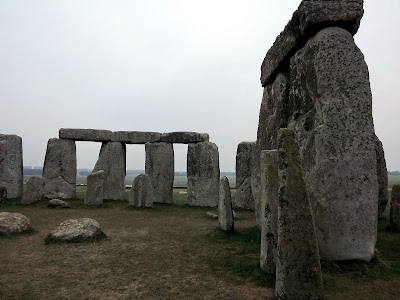Goat's Hole Cave, Paviland, on the Gower Peninsula. Below: an artist's reconstruction of the laying out of the young man whose bones are now dated to c 26,000 years BP
I have done a few posts in the past about Paviland and the Red Lady -- use the search facility to find them. In some recent posts I have been speculating about what might have happened in the Carmarthen bay and Cardigan Bay areas during the Early and Middle Devensian -- and Paviland is one of the few places where evidence from archaeology and geomorphology might come together to give us some answers.
A good summary of the state of knowledge about Paviland is found here:
http://www.britarch.ac.uk/ba/ba61/feat3.shtml
and there was a somewhat imaginative reconstruction or dramatisation of the interment of the young man (mistakenly referred to for many years as "The Red Lady") in the opening sequence of "The Story of Wales" on BBC1 the other evening. (You can see this sequence on the BBC iPlayer.)
http://www.bbc.co.uk/programmes/p00pj67h
http://www.bbc.co.uk/programmes/p00pd0jp
To quote from Stephen Aldhouse-Green:
At the time when the young man was ritually interred, there is no substantive evidence in this remote part of Europe for a human presence that was other than episodic. Indeed, faunal compositions and densities probably oscillated over time and space. Human presence in the British early Upper Palaeolithic may plausibly be linked to a 'biomass expansion', an overall increase in the availability of animals and other forms of food, centred on the 29th millennium. The coincidence of the dating of burnt bones to this period, combined with the presence of burnt Aurignacian artefacts, supports this as the most likely time for Aurignacian presence at Paviland. Radiocarbon dating of an Aurignacian bone spearpoint to around 28,000 bp at nearby Uphill lends additional weight to this interpretation.
Gravettian visitation is attested by a scatter of large tanged points occurring across southern Britain, including Paviland. Such points are generally dated to 28-27,000 BP, although their use may possibly extend down to the time of the 'Red Lady' burial..........
............ Restudy of the Goat's Hole lithic collections has confirmed material ranging from about 40,000 BP to about 13,000 BP (including Mousterian, leaf point, late Aurignacian, early Gravettian, Creswellian, and Final Upper Palaeolithic phases), although the earliest and latest phases are not dated by radiocarbon. Aurignacian finds form the dominant element. These artefacts were made from a range of imported and local raw materials.
So the signs are that there was possibly continuous -- or more likely intermittent -- occupation of this Carmarthen Bay coastal area right through from the Early Devensian to the Late Devensian. The most favourable conditions for occupation might well have occurred during the episode known as the Upton Warren Interstadial. Did the occupants of Goat's Hole and the other limestone caves around this coastal lowland (including the Caldey Island caves) also live here and die here at the peak of the Devensian glaciation, around 23,000 years ago? With Devensian glaciers coming down from the Welsh valleys and creating end moraines not far from the position of the present coastline, did the hunters of the time occasionally stray onto the ice, or hunt along the ice edge? Or was there such a hostile environment at the time that they retreated southwards, and returned once the glaciers had started to melt away? And what is the relationship of Paviland Cave to the Paviland Moraine (supposedly of Anglian age) of Prof David Bowen?
Could Devensian ice have actually flowed across the mouth of the cave and sealed it off for a while? The current consensus is that this did not happen, and that the ice edge lay maybe a couple of miles to the north, across the middle of the Gower Peninsula; but I am not all that convinced by the evidence for that, and as I have said earlier, I think that Devensian ice might well have overridden Caldey Island and substantial parts of the territory now submerged beneath the waters of Carmarthen Bay.
Lots more questions.....







































